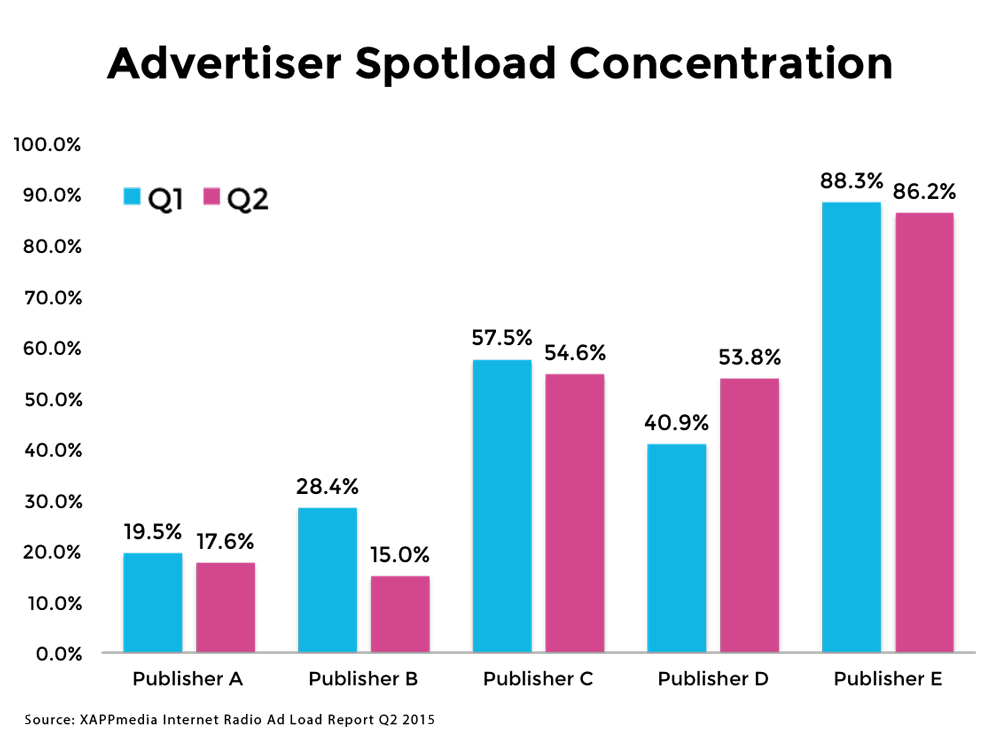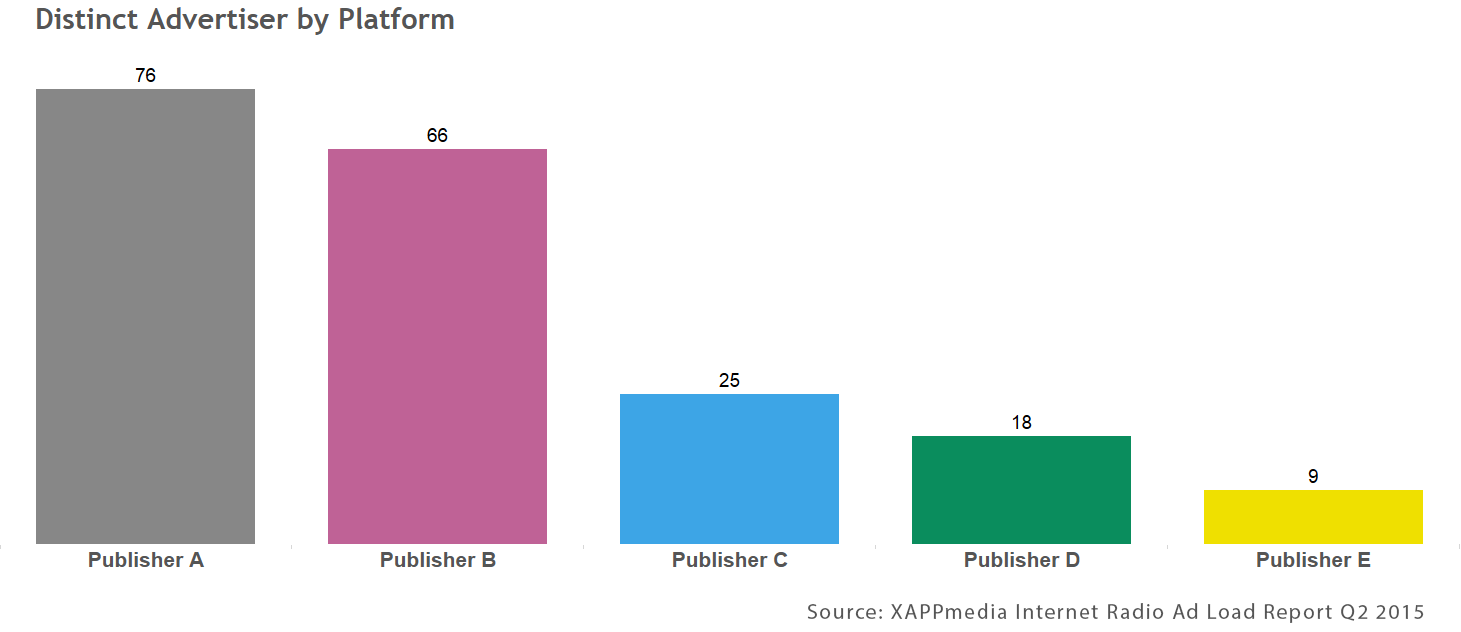One of the headlines from the Q2 Internet Radio Ad Load Report published last week was continued growth in the number of advertisers identified. More advertisers indicate broader interest in Internet radio as an advertising channel. It also means less reliance on a few national advertisers and more options for publishers to sell ever-increasing ad inventory. However, the growth in advertiser diversity is not developing equally across publishers. Two publishers have expanded their advertising base significantly while three others have not.
Two Publishers Generate More Advertiser Interest
Over the past two quarters, Publishers A and B have shown substantial growth in advertiser diversity. Seventy-six distinct advertisers were identified on Publisher A during the second quarter and 66 were found on Publisher B. Both showed an increase of 20 distinct advertisers over the first quarter that resulted in a rise of 36% for Publisher A and 43% for Publisher B.
Advertiser Diversity is Inversely Related to Ad Spot Concentration
 As a result of the increase in advertiser diversity, the top five advertisers on Publisher A accounted for only 17.6% of the company’s ad spots served. That was down by nearly 2% from the previous quarter when it exhibited the lowest concentration. The addition of new advertisers had a bigger impact on Publisher B’s ad spot concentration. The top five advertisers accounted for only 15.0% of ads in Q2 compared to 28.4% in Q1. These numbers gave Publisher B the least advertiser spot concentration for the quarter.
As a result of the increase in advertiser diversity, the top five advertisers on Publisher A accounted for only 17.6% of the company’s ad spots served. That was down by nearly 2% from the previous quarter when it exhibited the lowest concentration. The addition of new advertisers had a bigger impact on Publisher B’s ad spot concentration. The top five advertisers accounted for only 15.0% of ads in Q2 compared to 28.4% in Q1. These numbers gave Publisher B the least advertiser spot concentration for the quarter.
Publisher D actually showed lower advertiser diversity in the second quarter combined with higher ad spot concentration. Distinct advertisers identified fell from 22 to 18 during the period and its concentration for the top five advertisers grew rapidly from 40.9% to 53.8%. Publisher E was unchanged in advertiser diversity with nine in both quarters and its advertiser concentration fell slightly from 88.3% to 86.2%.
Publisher C showed quarterly growth in distinct advertisers that looks impressive in percentage terms, 39%. However, it was a net increase of seven off of a base of only 18 in the first quarter and a review of the monthly numbers shows a consistent fluctuation around 20 distinct advertisers. Despite the large relative rise in distinct advertisers, ad spot concentration fell only 4% from 57.5% of spots in Q2 compared to 53.4% the previous quarter. If Publisher C can add another 7-10 distinct advertisers in the third quarter and balance the spot load among them, it would start to show a more favorable trend than the monthly numbers indicate.
The Benefits of Advertiser Diversity and Low Ad Spot Concentration
The benefit of having more advertiser diversity is clear. There is greater competition for publisher ad inventory and less reliance on the quarterly ad budget of any one marketer. This should lead to less quarterly revenue volatility and a greater ability to maintain ad inventory rates.
The two publishers with the largest number of distinct advertisers were also the only apps to run local audio ads in addition to national ads and they also exhibited the lowest ad spot concentration by a wide margin. The average ad spot concentration among the top five advertisers was only 16% while two of the other publishers had concentration around 54% and the highest was 86%. That means Publishers A and B had between 1/3 and ¼ the reliance on large national advertisers as the other services.
Considering the number of large national advertises identified, Publishers C, D and E could reduce spot concentration by simply adding more in this category. The faster way to grow advertiser diversity is to introduce local advertisers to the mix. That strategy requires geo-targeting capabilities and a critical mass of listeners. Those qualities are also valued by national advertisers so ensuring audience growth and the ability to target should help in attracting more advertisers of all sizes.
To learn more about advertisers on Internet radio and publisher advertising practices, download the Internet Radio Ad Load Report Q2 2015.
Related Posts
More Local Advertisers and Higher Ad Load on Internet Radio in Q2
Internet Radio in Q1 – Ad Load Falls, New Advertisers Rise
More Advertisers Identified on Internet Radio


